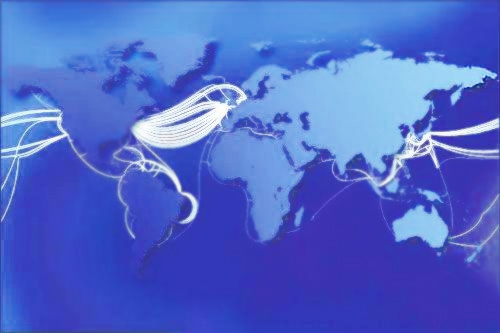Internet Infrastructure: Pipe Dreams
互联网基础设施:深海织梦
Technology companies are building their own undersea fibre-optic networks
科技公司正在打造自己的海底光纤网络
When Cyrus Field, an American businessman, laid the first trans-Atlantic cable in 1858, it was hailed as one of the great technological achievements of its time and celebrated with bonfires, fireworks and 100-gun salutes. Alas, the reason for the festivities soon went away. Within weeks the cable failed.
当美国商人塞勒斯·菲尔德(Cyrus Field)在1858年敷设第一条横跨大西洋的电缆时,人们盛赞它是当时最伟大的科技成就之一,他们用篝火、烟花和100响礼炮来庆祝。然而好景不长,不过几周,电缆便损坏失灵了。
On September 21st the completion of another trans-Atlantic cable was welcomed with much less ado. But it is remarkable nevertheless: dubbed Marea, Spanish for “tide”, the 6,600km bundle of eight fibre-optic threads, roughly the size of a garden hose, is the highest-capacity connection across the ocean. Stretching from Virginia Beach, Virginia, to Bilbao, Spain, it is capable of transferring 160 terabits of data every second, the equivalent of more than 5,000 high-resolution movies. It is jointly owned by Facebook and Microsoft.
今年9月21日,又一条跨大西洋电缆完工。这次人们的欢庆方式要低调得多,但这并不影响它是一项非同凡响的成果:这条名为“马雷亚”(Marea,西班牙语“潮汐”的意思)的电缆是目前容量最大的跨大西洋通信线路。它全长6600公里,由8条光纤线路组成,和花园用的水管差不多粗细。它从美国弗吉尼亚州的弗吉尼亚海滩(Virginia Beach)延伸至西班牙的毕尔巴鄂(Bilbao),每秒可以传输160Tb的数据,相当于5000多部高分辨率的电影。这条电缆由Facebook和微软共有。

Such ultra-fast fibre networks are needed to keep up with the torrent of data flowing around the world. In 2016 traffic reached 3,544 terabits per second, roughly double the figure in 2014, according to TeleGeography, a market-research firm. And demand for international bandwidth is growing by 45% annually. Much traffic still comes from internet users, but a large and growing share is generated by big internet and cloud-computing companies syncing data across their networks of data centres around the world.
为了跟上世界范围内涌动的数据洪流,人们需要这种超高速光纤网络。根据市场调研公司TeleGeography的数据,2016年通信流量达到每秒3544Tb,大约是2014年时的两倍。对国际带宽的需求也在以每年45%的速度增长。相当一部分通信流量仍然来自互联网用户,不过大型互联网和云计算公司在它们遍布世界的数据中心网络之间进行的数据同步也占了很大的比例,这一比例还在不断增长。
These firms used to lease all of their bandwidth from carriers such as BT and Level 3. But now they need so much network capacity that it makes more sense to lay their own dedicated pipes, particularly on long routes between their data centres. The Submarine Telecoms Forum, an industry body, reckons that 100,000km of submarine cable was laid in 2016, up from just 16,000km in 2015. TeleGeography predicts that a total of $9.2bn will be spent on such cable projects between 2016 and 2018, five times as much as in the previous three years.
这些公司过去通常是从英国电信(BT)和美国Level 3之类的运营商那里租赁自己所用的全部带宽。但现在它们对网络容量的需求非常庞大,因此敷设自己的专用线路变得更加合理,尤其是在它们相隔甚远的各个数据中心之间敷设线路。行业机构海底电信论坛(Submarine Telecoms Forum)估算,2016年敷设的海底电缆达10万公里,而2015年仅有1.6万公里。据TeleGeography预测,2016年至2018年间,总计会有92亿美元花在这类电缆项目上,是之前三年的五倍之多。
Owning a private subsea fibre-optic network has several advantages, including more bandwidth, lower costs, and reduced delay, or “latency”. Having access to multiple cables on different routes also provides redundancy. If a cable is severed – by fishing nets, sharks, or an earthquake, among other things – traffic can be rerouted to another line. Most important, however, owning cables gives companies greater say over how their data traffic is managed and how equipment is upgraded. “The motivation is not so much saving money. It’s more about control,” says Julian Rawle, a submarine cable-industry expert.
自有海底光纤网络有几个好处,包括更多的带宽,更低的成本,还能减少延迟。使用不同线路的多条电缆还能提供备用路径:如果一条电缆因渔网、鲨鱼、地震等原因断裂,通信可切换到另一条电缆上。不过最重要的是,拥有自己的电缆后,公司在数据传输的管理和设备升级等方面就有了更大的话语权。“这么做的动机主要不是为了省钱,更多是为了控制。”海底电缆业专家朱利安·罗尔(Julian Rawle)表示。
英文、中文版本下载:http://www.yingyushijie.com/shop/source/detail/id/421.html








